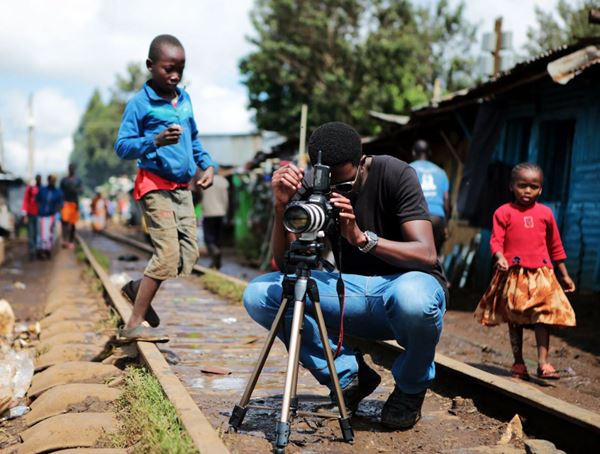NFTs have opened up a potentially lucrative new world for artists in developing economies
Rich Allela, like so many other artists, had his career upended by the pandemic. The Nairobi-based photographer’s income quickly dried up during Kenya’s partial lockdowns in 2020. He tried alternatives—affiliate marketing, YouTube videos. Nothing stuck. And then a friend introduced him to nonfungible tokens (NFTs). “It was a total game changer,” says Allela. “It enabled me to have the freedom to create work again without having to think constantly about making art for money and to pay bills.”
Unlike physical money and cryptocurrencies, NFTs are not interchangeable. They’re like physical collector’s items—only digital—of artwork, videos, music, and in-game purchases. And they’ve taken the art and collectibles world by storm. Crypto millionaires with Ethereum to spend can now invest directly in NFTs, keeping money within the cryptocurrency ecosystem. Rapidly rising prices and the prospect of big returns have contributed to the boom.
Trading in NFTs hit $17.6 billion last year, according to a report from NFT data company Nonfungible.com. Chainalysis puts the figure at more than $40 billion.
The prices can be staggering. One of Larva Labs’ CryptoPunks—a collection of 10,000 uniquely generated “punk” characters dreamt up by two creative technologists—last year sold for a whopping $23.7 million to the CEO of Chain, a blockchain-based tech company. Commonly credited with starting the NFT craze, CryptoPunks could originally be claimed for free by anybody with a digital Ethereum wallet. Just four years later, the cheapest available is ETH 60.95 (about $128,000 as of May 14).

RICH ALLELA, A PHOTOGRAPHER BASED IN NAIROBI, HAS TURNED TO NFTS AS A SOURCE OF INCOME. (PHOTO: COURTESY OF RICH ALLELA)
However, for creators like Allela, NFTs are growing in popularity because they solve a long-standing problem: how to monetize digital artwork. For artists, photographers, animators, and others, potentially lucrative opportunities are opening up—particularly in developing economies, where content creators previously had difficulty marketing and selling in the multibillion-dollar traditional art market.
Shaking up the art world
When people create, or “mint,” an NFT, they execute code stored in smart contracts that assign ownership through a unique ID and metadata. Because the information is recorded in the blockchain—a public distributed ledger—ownership can be easily verified. So even though an NFT can be copied or forged, ownership of the metadata associated with the work cannot. This is a radically important concept.
Prior to the blockchain, digital artists struggled to prove that they were the original creator of a work. The advent of NFTs changed that, upending the commercial gallery business model, which has traditionally taken the lion’s share of art market profits. Artists trade directly online, typically via marketplaces like OpenSea or Nifty Gateway, cutting out the need for a dealer. Rather than sacrificing a hefty 40 to 50 percent to a gallery owner, they pay a small transaction fee.
Crucially, in contrast to the traditional art world, flipping is rampant. A no-no in the industry, flipping artwork is usually quashed by galleries’ vetting of collectors and dealers. But with NFTs, anyone can buy, often anonymously, tempting investors to quickly resell at a profit rather than hold, as true collectors would.
Osinachi, Nigeria’s most bankable digital artist, who creates his work using Microsoft Word, doesn’t think this is all that bad. “In the traditional art space most times the artist doesn’t even know that ownership of the work has changed,” he says. “But in the NFT space, you get your royalties in real time as people are reselling and flipping.”
NFTs enable artists to get a cut of any future sales, providing a degree of financial security most traditional artists don’t have. When artists sell work on the blockchain they sign a self-executing agreement with the buyer that ensures royalties—often between 10 and 30 percent. For artists, “that is really big,” says Osinachi. “Even when you pass on, if someone who is a relative has access to your wallet, they get royalties that would come through your work.”
NFTs are not without their challenges, however. Crypto’s environmental track record is dismal, and scams are rife. The most notorious is the “rug pull”: creators quickly cash out after launching what appears to be a legitimate crypto project and then abscond with investors’ funds. Crypto investors lost over $2.8 billion to rug pulls last year, according to a report by Chainalysis. Cybercrime is also a real risk, ranging from account takeovers to fake marketplaces.
Allela was concerned about security when he minted his first work and encourages those thinking about entering the space to do their own research and seek out a community. He thinks there are still too few African artists in the NFT space—its complexity, difficulties building a following, and the gas fees (the cost of a transaction on the blockchain) are a hindrance. But he remains an optimist and has big ambitions for the future. In addition to digitizing his work, he now runs a company working with 157 artists across Africa to “revolutionize the African digital space,” he says. “We’re looking at generating $2–$5 million from sales this year. Just to show people it’s possible.”
Opinions expressed in articles and other materials are those of the authors; they do not necessarily reflect IMF policy.









